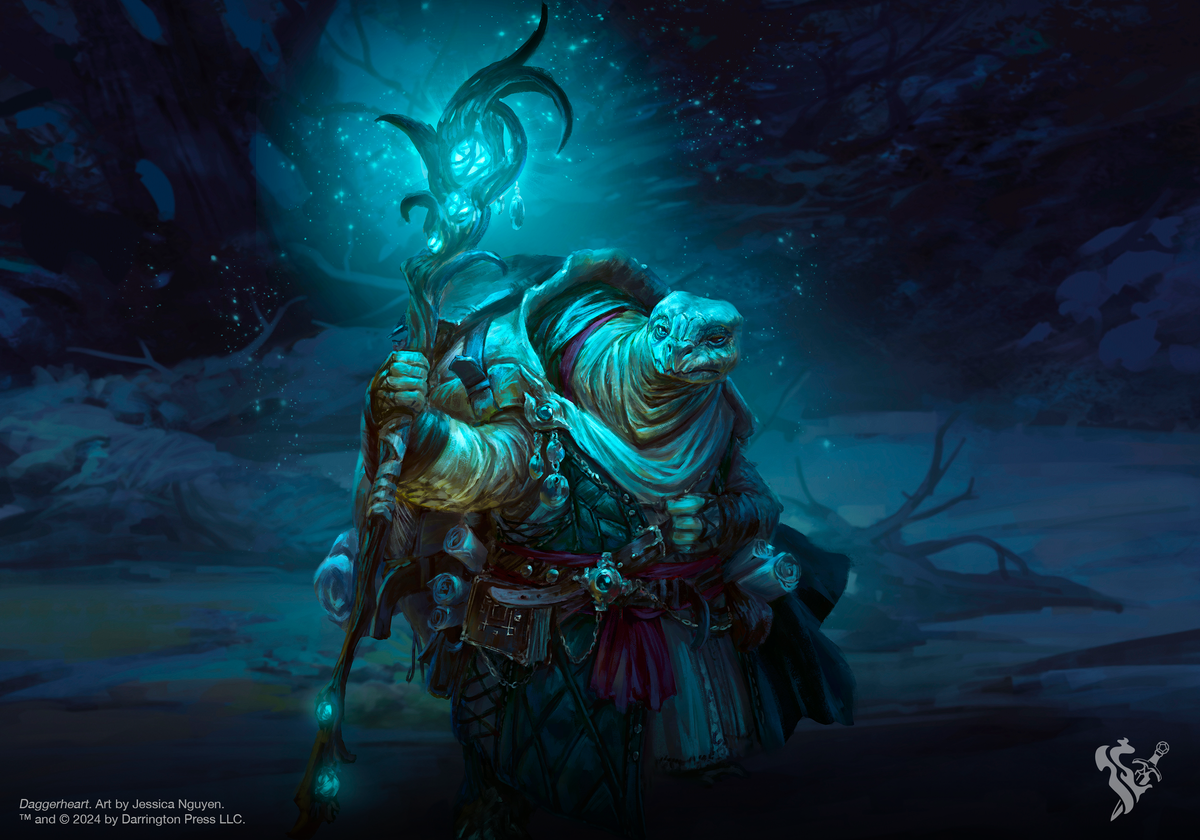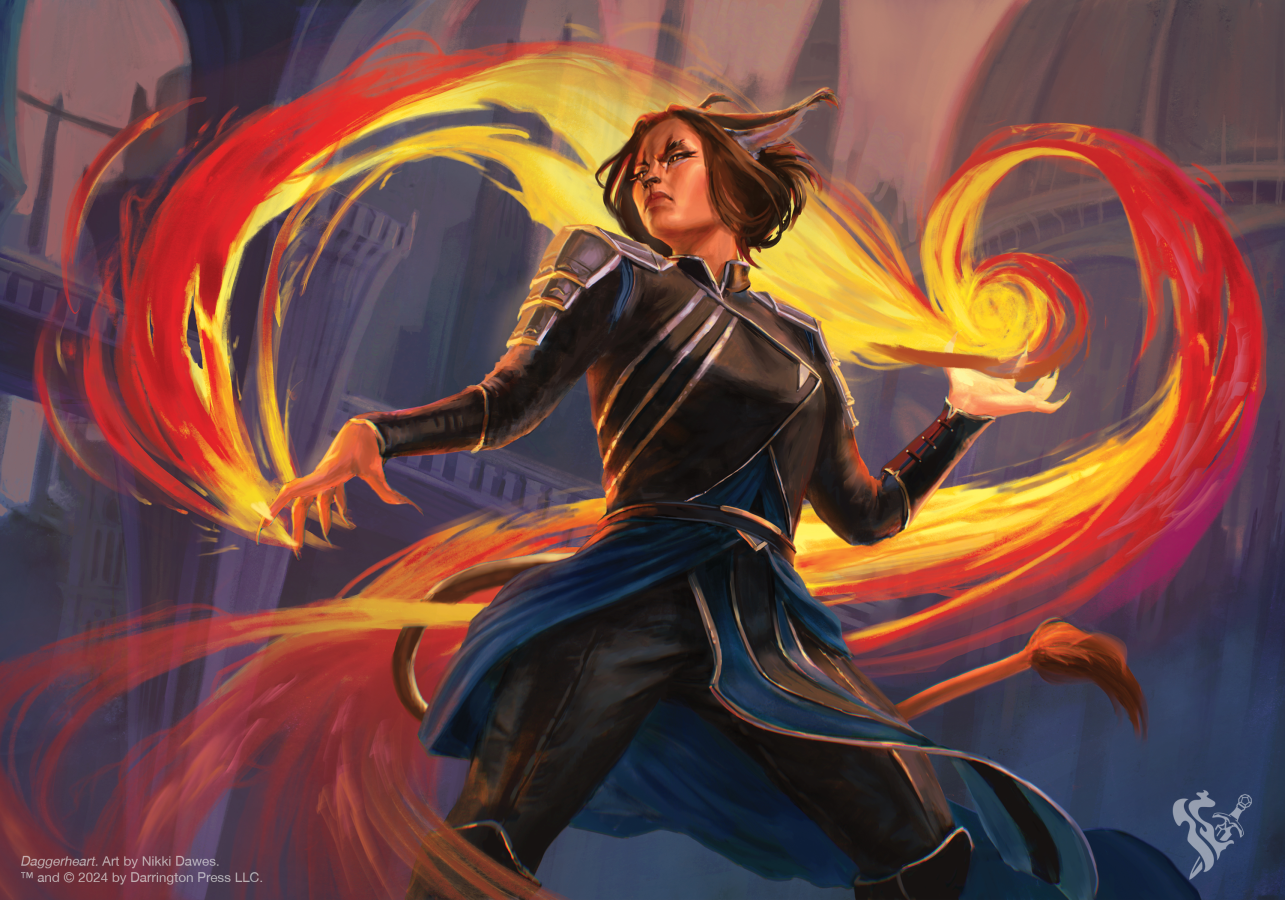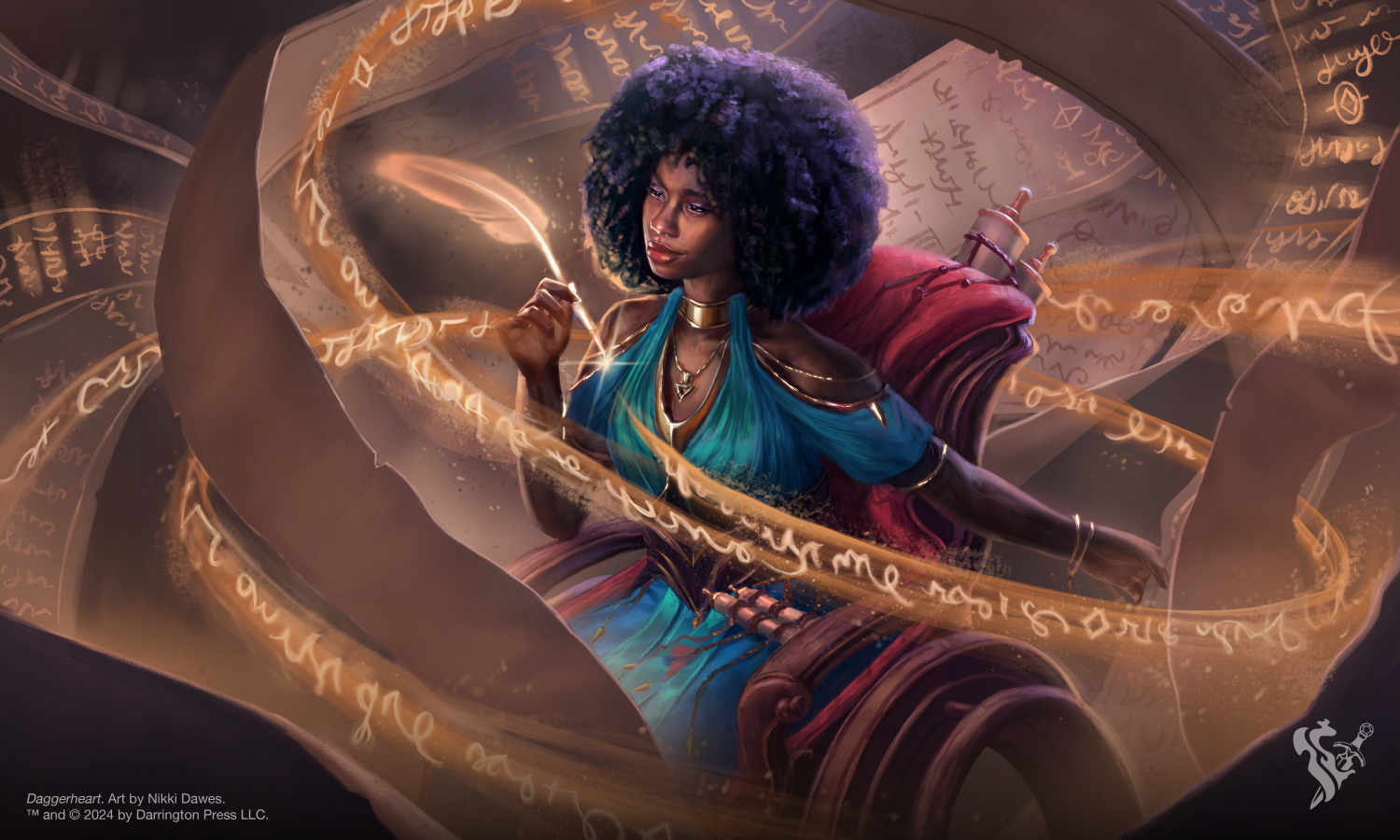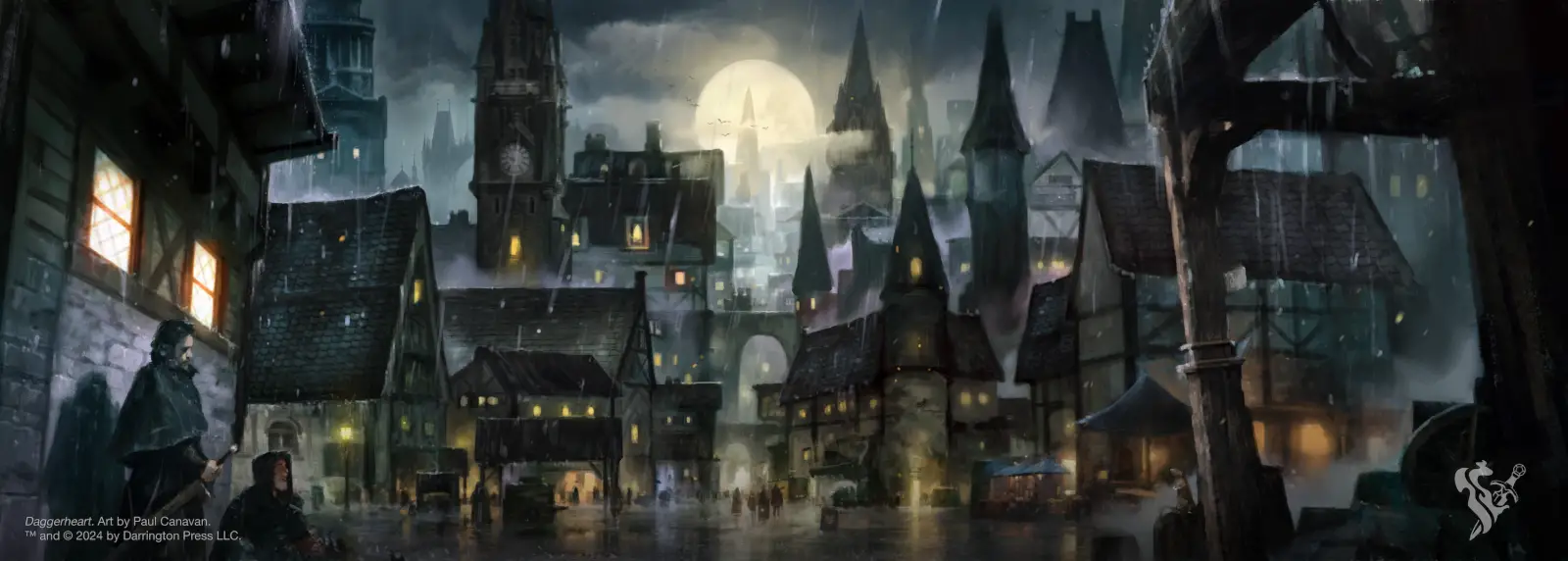
Daggerheart is Darrington Press’ answer to D&D. Hasbro’s leadership just concluded a year of showing active disdain for their partners and customers, spurring Darrington and others to make their own way and steer their audience towards new horizons. Daggerheart’s playtest document is out, giving us a glimpse of its mechanics and philosophy. The contents of this document show enormous potential, but need some tweaks to deliver a game worthy of attention. As compared to the final release of Candela Obscura, this leaves me optimistic. Both games enter fields crowded with quality games, and both will struggle to compete. Whereas Candela Obscura needed a top down overhaul to stand out, Daggerheart could achieve success with just a few more options and some tweaks to its combat engine.
If there is anything I wish most about Daggerheart, it’s that it would step further away from the auspices of Dungeons and Dragons. Most of Daggerheart’s new ideas are fresh, engaging, and weighted to make for great gameplay. Its D&D trappings are comparatively anemic and unnecessary. I understand that Darrington needs to make some concessions to ease its playerbase off of the Wizard’s Coast, but with the vision their new mechanics show, I think they should trust to their particular strengths and examine how the new mechanics could shine in their own context.
BASE MECHANICS

Daggerheart’s main mechanic relies on two twelve sided dice, Hope and Fear, which you roll for every task, then adding both values to one of your six Traits, analogous but not directly identical to D&D’s six attributes. Advantage and disadvantage consist of a separate d6 added or subtracted from your total, which you compare to the task’s difficulty. All doubles are critical successes. The twist has shades of Don’t Rest Your Head, a masterful horror game I would expect no one at Darrington has read: whichever die value is higher between Hope and Fear adds extra complications, either positive or negative. You could succeed or fail with Hope or Fear, giving every die roll extra consequences and weight. Even a minor skill check could build Hope points for future use or cause events to spiral out of control.
At first blush, this base mechanic is genius. It’s a simple way to give momentum to the story that carries through to the game’s combats. I would love to see the dual dice mechanic expanded on, maybe with a dark side/corruption mechanic. On its own, it’s an immediately graspable rule (check whether the good or bad dice is higher) that functions as a condensed version of Fantasy Flight’s Genesys dice. Whether you succeed or fail on the roll doesn’t necessarily correspond to whether circumstances are trending in a good or bad direction. Any final judgment on this system can only rest on a completed version and substantial playtime. I am concerned that a run of good or bad rolls could cause too great a shift towards good or bad. Too many Hope rolls and you’ll be flush with resources. Too much Fear and everything starts to collapse. Hope rolls fuel class abilities, which you can sometimes extend to other characters.
CHARACTERS

Character creation follows some familiar beats. You will choose a class from familiar staples like Rogue, Wizard, or the divine infused Seraph. Each comes with different damage thresholds, subclasses referred to as Foundations, and useful abilities. The Seraph, for instance, has prayer dice they can call upon to enhance rolls. From there you decide upon your Domain, a set of special abilities that are stored on reference cards. There is little other card use in the game, no reason these couldn’t be written on a character sheet, and not enough cards for players who share Domains. This suggests Domains are a quick way to create a supplement to get extra revenue, useful though it is to have the card as a reference. You will then decide upon your Heritage, consisting of Ancestry and Community, essentially taking the place of Race and Background. Following that you apply bonus points to your six traits, grab some equipment, and decide upon connections between you and the other characters.
All of these steps sound formulaic, but that stops when you take the time to read through the class and heritage options. There are lots of small changes, often playing around with the Hope and Fear mechanic, that give Daggerheart its own identity. I would love to see Daggerheart take that one step further and craft its own setting. Though it strikes out in many ways, there’s no ignoring the influence D&D holds over this game. The Heritages are all either animal people or pulled directly from Faerun-esque settings. You’ll see turtle people and frog people, but also elves, orcs, dwarves, and other conventions. The most unique would be the Fungril, sentient mushrooms who can tap into a shared intelligence network. The classes are all either familiar or direct offshoots of ones we have seen before. This being a playtest, the character options are the most incomplete, and the most difficult to judge. Generally speaking they have few abilities that are impactful to your experience, well based in the game’s dice mechanics.
COMBAT

Combat has a few small but impactful tweaks to the rest of the engine. Taking and preventing damage is more strategic and more at the core of combat than typical HP rules. Armor reduces damage but only a set number of times before it stops functioning and needs to be repaired. Each character has several set damage thresholds. When they receive damage enough to hit a threshold, they lose greater numbers of HP, from 1-3. You start with 6hp and might get more from other sources, so 3 is a huge hit. If you take damage below your lowest threshold, you instead receive a Stress; at 5 Stress any amount of damage removes at least 1 HP, and some classes have abilities that can be activated in exchange for receiving Stress. When your character faces death, you can choose between one of the following: 1. Go out in a blaze of glory with an automatic critical success. 2. Survive with 1 HP, but permanently lose 1 maximum Hope Point. (It was unclear from my read of the rules, but I think that if you lose all Hope Points you die). 3. Roll your dice and base your survival on whether Hope wins out against Fear.
The damage and death mechanics have a great level of granularity and risk. If you fall do you take a 50/50 chance, guarantee death with success, or guarantee survival with a permanent scar? When do you use your armor? When do you use your Stress? No matter what, you are running low on resources and protections, but in a way that makes you more vulnerable and leaves you with more options than a D&D character.
The biggest point of contention with Daggerheart is its initiative system, or rather its refusal to have one. This is a bad idea and they need to change it, but only because the initiative system that the game is almost using would be fantastic. In the current rules, players take as many actions as they want in whatever order they want, with no real restriction. As they do so, they place Action tokens on a card, which accumulate. The GM can spend those tokens to take actions, using more tokens for more devastating effects. There is nothing firm here about when the GM takes actions, just some wishy-washy advice that should be done away with. They tell you to “consider” letting a player take an action if they haven’t in a while, and that you “should” take an action after a player rolls Fear. If they get rid of these suggestions and make some firmer decisions, they will have a stronger, better designed game, all while keeping some mechanical levers they can build off of with abilities. Lacking formal initiative can put the game in an awkward space, where turn order is decided by narrative flow and a nebulous sense of fairness. Other ‘Powered by the Apocalypse’ games do this as well, treating combat as little different from any other encounter. Those games don’t have as many rules geared towards combat, and more importantly don’t have the bones for a much better initiative system.
If this initiative had two slight changes, it would have a lovely risk/reward mechanism behind every action. Just make sure every player takes an action before anyone goes twice, and have the GM act on every Fear roll, and it gives structure to the combat while putting pressure on every move. Every action by the players would risk reprisal, and the longer the GM goes without taking a turn, the more ammunition they have to use on that turn. It would automatically balance itself, both for and against the players. The players would lose a guaranteed advantage with action economy, and too many GM turns in a small time frame means they would have less impactful actions to use. The GM could choose to save actions for a bigger hit later on, or pick away at the players at every opportunity. This would also open up fertile ground for powers both positive and negative to affect the action pool, a visible and easily trackable tool.
FINAL THOUGHTS

I count myself impressed by Daggerheart, if with some reservation. After Candela Obscura struggled to stand out, this fantasy alternative already boasts some smart decisions. The game’s rules show an elegance, wherein simple decisions with clear consequences add decision points to every aspect of the game. I could see Darrington expand on these ideas, using the action pool system for chase scenes or extended opposed tests. We are a ways out from release, and I hope the team takes time to examine what Daggerheart could be if it trusts in its own vision. Time will tell.
